Abstract
Several economically important genes of rice govern various key traits however, their allelic (haplotype) combinations remain unexplored. Elongation of internode underwater is a unique trait that is specific to deep water rice. In the current study, a haplotype network of 18 expression quantitative trait loci (eQTLs) related to internode elongation has been investigated among selected 92 deep water rice landraces, one IRRI cultivar, and one African landrace. This analysis categorized all these genotypes into different haplotype groups based on the SNPs of internode-specific eQTLs. Our results revealed a maximum of 16 haplotypes with the eQTL, SET protein 39 with 42 SNPs, and a minimum of 3 haplotypes for 5 different eQTLs. Maximum haplotype diversity in SET protein 39 (Os10g36250) eQTL was found to be 0.8094, indicating that it possesses the highest level of allelic variation whereas, the lowest haplotype diversity i.e., 0.0423 was found in Annexin repeat, conserved site domain-containing protein (Os03g17634) eQTL. Our study opens up the new possibility for developing improved rice varieties comprising desired superior haplotype combinations of target genes responsible for internode elongation under deep water treatment through haplotype-based breeding.






Similar content being viewed by others
Abbreviations
- SNP:
-
Single nucleotide polymorphism
- eQTLs:
-
Expression quantitative trait loci
- DWR:
-
Deep water rice
- NJ:
-
Neighbour-joining
- LD:
-
Linkage disequilibrium
- Hd:
-
Haplotype diversity
- AAO:
-
Ascorbate oxidase
References
Bailey-Serres J, Voesenek LA (2008) Flooding stress: acclimations and genetic diversity. Annu Rev Plant Biol 59:313–339
Bailey-Serres J, Voesenek LA (2010) Life in the balance: a signaling network controlling survival of flooding. Curr Opin Plant Biol 13:489–494
Bandelt HJ, Forster P, Rohl A (1999) Median-joining networks for inferring intraspecific phylogenies. Mol Bio Evol 16:37–48
Barrera-Figueroa BE, Gao L, Wu Z, Zhou X, Zhu J, Jin H, Liu R, Zhu JK (2012) High throughput sequencing reveals novel and abiotic stress-regulated microRNAs in the inflorescences of rice. BMC Plant Boil 12:1–11
Bevan MW, Uauy C, Wulff BB, Zhou J, Krasileva K, Clark MD (2017) Genomic innovation for crop improvement. Nature 543:346–354
Bradbury PJ, Zhang Z, Kroon DE, Casstevens TM, Ramdoss Y, Buckler ES (2007) TASSEL: software for association mapping of complex traits in diverse samples. Bioinformatics 23:2633–2635
Crowell S, Korniliev P, Falcao A, Ismail A, Gregorio G, Mezey J, McCouch S (2016) Genome-wide association and high-resolution phenotyping link Oryza sativa panicle traits to numerous trait-specific QTL clusters. Nature Commun 7:1–4
Dixit N, Dokku P, Mithra SA, Parida SK, Singh AK, Singh NK, Mohapatra T (2013) Haplotype structure in grain weight gene GW2 and its association with grain characteristics in rice. Euphytica 192:55–61
Doyle JJ, Doyle JL (1987) A rapid DNA isolation procedure for small quantities of fresh leaf tissue. Phytochem Bull 19:11–15
Drost DR, Benedict CI, Berg A, Novaes E, Novaes CR, Yu Q, Dervinis C, Maia JM, Yap J, Miles B, Kirst M (2010) Diversification in the genetic architecture of gene expression and transcriptional networks in organ differentiation of Populus. Proc Natl Acad Sci 107:8492–8497
Druka A, Potokina E, Luo Z, Jiang N, Chen X, Kearsey M, Waugh R (2010) Expression quantitative trait loci analysis in plants. Plant Biotechnol J 8:10–27
Earl DA, Vonholdt BM (2012) STRUCTURE HARVESTER: a website and program for visualizing STRUCTURE output and implementing the Evanno method. Conserv Genet Resour 4:359–361
Evanno G, Regnaut S, Goudet J (2005) Detecting the number of clusters of individuals using the software STRUCTURE: a simulation study. Mol Ecol 14:2611–2620
Hattori Y, Nagai K, Furukawa S, Song XJ, Kawano R, Sakakibara H, Wu J, Matsumoto T, Yoshimura A, Kitano H, Matsuoka M (2009) The ethylene response factors SNORKEL1 and SNORKEL2 allow rice to adapt to deep water. Nature 460:1026–1030
Hattori Y, Nagai K, Ashikari M (2011) Rice growth adapting to deep water. Curr Opin Plant Bio 14:100–105
Jansen RC, Nap JP (2001) Genetical genomics: the added value from segregation. Trends Genet 17:388–391
Kende H, Van Der Knaap E, Cho HT (1998) Deep water rice: a model plant to study stem elongation. Plant Physiol 118:1105–1110
Kim SR, Ramos JM, Hizon RJ, Ashikari M, Virk PS, Torres EA, Nissila E, Jena KK (2018) Introgression of a functional epigenetic OsSPL 1 4 WFP allele into elite indica rice genomes greatly improved panicle traits and grain yield. Sci Rep 8:1–2
Kliebenstein D (2009) Quantitative genomics: analyzing intraspecific variation using global gene expression polymorphisms or eQTLs. Annu Rev Plant Biol 60:93–114
Kuroha T, Nagai K, Kurokawa Y, Nagamura Y, Kusano M, Yasui H, Ashikari M, Fukushima A (2017) eQTLs regulating transcript variations associated with rapid internode elongation in deep-water rice. Front Plant Sci 8:1753
Li Y, Xiao J, Chen L, Huang X, Cheng Z, Han B, Zhang Q, Wu C (2018) Rice functional genomics research: past decade and future. Mol Plant 11:359–380
Loreti E, van Veen H, Perata P (2016) Plant responses to flooding stress. Curr Opin Plant Biol 33:64–71
Lowry DB, Logan TL, Santuari L, Hardtke CS, Richards JH, DeRose-Wilson LJ, McKay JK, Sen S, Juenger TE (2013) Expression quantitative trait locus mapping across water availability environments reveals contrasting associations with genomic features in Arabidopsis. Plant Cell 25:3266–3279
Mickelbart MV, Hasegawa PM, Bailey-Serres J (2015) Genetic mechanisms of abiotic stress tolerance that translate to crop yield stability. Nat Rev Genet 16:237–251
Nagai K, Hattori Y, Ashikari M (2010) Stunt or elongate? Two opposite strategies by which rice adapts to floods. J Plant Res 123:303–309
Nagai K, Mori Y, Ishikawa S, Furuta T, Gamuyao R, Niimi Y, Hobo T, Fukuda M, Kojima M, Takebayashi Y, Fukushima A (2020) Antagonistic regulation of the gibberellic acid response during stem growth in rice. Nature 584:109–114
Pritchard JK, Stephens M, Donnelly P (2000) Inference of population structure using multilocus genotype data. Genet 155:945–959
Rohilla M, Roy P, Chowdhury D, Sharma KK, Saikia P, Sen P, Singh NK, Mondal TK (2019) Bao Dhan of Assam: organically grown indigenous rice slated to increase farmer’s income. Curr Sci 116:706–708
Rohilla M, Singh N, Mazumder A, Sen P, Roy P, Chowdhury D, Singh NK, Mondal TK (2020) Genome-wide association studies using 50 K rice genic SNP chip unveil genetic architecture for anaerobic germination of deep water rice population of Assam, India. Mol Genet Genom 295:1211–1226
Rozas J, Sanchez-Del Barrio JC, Messeguer X, Rozas R (2003) DnaSP, DNA polymorphism analyses by the coalescent and other methods. Bioinformatics 19:2496–2497
Schadt EE, Monks SA, Drake TA, Lusis AJ, Che N, Colinayo V, Ruff TG, Milligan SB, Lamb JR, Cavet G, Linsley PS (2003) Genetics of gene expression surveyed in maize, mouse and man. Nature 422:297–302
Singh N, Jayaswal PK, Panda K, Mandal P, Kumar V, Singh B, Mishra S, Singh Y, Singh R, Rai V, Gupta A (2015) Single-copy gene based 50 K SNP chip for genetic studies and molecular breeding in rice. Sci Rep 5:1–9
Singh N, Singh B, Rai V, Sidhu S, Singh AK, Singh NK (2017) Evolutionary insights based on SNP haplotypes of red pericarp, grain size and starch synthase genes in wild and cultivated rice. Front Plant Sci 8:972
Tao W, Lijuan L, Zeyu L, Lianguang S, Quan W (2021) Cloning and characterization of protein prenyltransferase alpha subunit in rice. Rice Sci 28:557–566
Varshney RK, Terauchi R, McCouch SR (2014) Harvesting the promising fruits of genomics: applying genome sequencing technologies to crop breeding. PLoS Biol 12:1001883
Varshney RK, Thudi M, Pandey MK, Tardieu F, Ojiewo C, Vadez V, Whitbread AM, Siddique KH, Nguyen HT, Carberry PS, Bergvinson D (2018) Accelerating genetic gains in legumes for the development of prosperous smallholder agriculture: integrating genomics, phenotyping, systems modelling and agronomy. J Exp Bot 69:3293–3312
Voesenek LA, Bailey-Serres J (2015) Flood adaptive traits and processes: an overview. New Phytol 206:57–73
Wang J, Yu H, Xie W, Xing Y, Yu S, Xu C, Li X, Xiao J, Zhang Q (2010) A global analysis of QTLs for expression variations in rice shoots at the early seedling stage. The Plant J 63:1063–1074
Wang Y, Han Y, Teng W, Zhao X, Li Y, Wu L, Li D, Li W (2014) Expression quantitative trait loci infer the regulation of isoflavone accumulation in soybean Glycine max L Merr seed. BMC Genom 15:1–1
West MA, Kim K, Kliebenstein DJ, Van Leeuwen H, Michelmore RW, Doerge RW, Clair DA (2007) Global eQTL mapping reveals the complex genetic architecture of transcript-level variation in Arabidopsis. Genetics 175:1441–1450
Wu L, Zhang Q, Zhou H, Ni F, Wu X, Qi Y (2009) Rice microRNA effector complexes and targets. Plant Cell 21:3421–3435
Zheng L, Huang F, Narsai R, Wu J, Giraud E, He F, Cheng L, Wang F, Wu P, Whelan J, Shou H (2009) Physiological and transcriptome analysis of iron and phosphorus interaction in rice seedlings. Plant Physiol 151:262–274
Acknowledgement
The authors are grateful to the Director, ICAR-National Institute for Plant Biotechnology. New Delhi for providing the facilities. The project was funded by Department of Biotechnology, Govt of India through a competitive grant # BT/PR40838/NER/95/1668/2020.
Author information
Authors and Affiliations
Corresponding author
Ethics declarations
Conflict of interest
I on behalf of all the authors declare that there is no conflict of interest among the authors.
Additional information
Publisher's Note
Springer Nature remains neutral with regard to jurisdictional claims in published maps and institutional affiliations.
Supplementary Information
Below is the link to the electronic supplementary material.
13562_2023_834_MOESM1_ESM.docx
Haplotype network of genes on chromosome 2: A) Pentatricopeptide repeat domain containing protein B) Plant glycogenin-like starch initiation protein a3 (DOCX 18 KB)
13562_2023_834_MOESM2_ESM.rtf
Haplotype network of genes on chromosome 3: a) WD40/YVTN repeat-like domain containing protein b) Annexin repeat, conserved site domain containing protein c) Vps52/Sac2 family protein d) Glycosyl transferase, family 2 domain containing protein (RTF 2825 KB)
13562_2023_834_MOESM3_ESM.rtf
Haplotype network of genes on chromosome 4: A) Protein prenyltransferase domain containing protein B) WD40-like domain containing protein (RTF 446 KB)
13562_2023_834_MOESM4_ESM.rtf
Haplotype network of genes on chromosome 6: A) MYC1 B) TPR-like domain containing protein C) L-ascorbate oxidase, Cold, salt, drought stress response (RTF 898 KB)
13562_2023_834_MOESM5_ESM.rtf
Haplotype network of gene named Protein of unknown function UPF0066 family protein on chromosome number nine (RTF 230 KB)
Rights and permissions
Springer Nature or its licensor (e.g. a society or other partner) holds exclusive rights to this article under a publishing agreement with the author(s) or other rightsholder(s); author self-archiving of the accepted manuscript version of this article is solely governed by the terms of such publishing agreement and applicable law.
About this article
Cite this article
Rohilla, M., Singh, N., Singh, J. et al. Exploration of eQTLs regulating transcript for internode elongation under deep water treatment employing haplotype network in diverse deep water rice landraces of Assam, India. J. Plant Biochem. Biotechnol. 32, 525–535 (2023). https://doi.org/10.1007/s13562-023-00834-4
Received:
Accepted:
Published:
Issue Date:
DOI: https://doi.org/10.1007/s13562-023-00834-4




